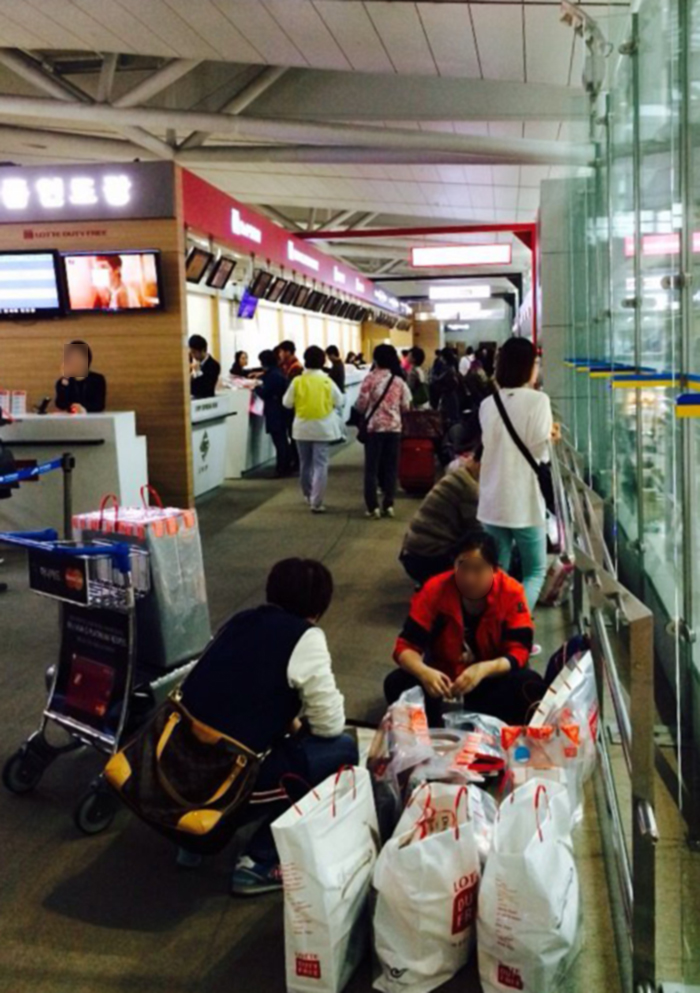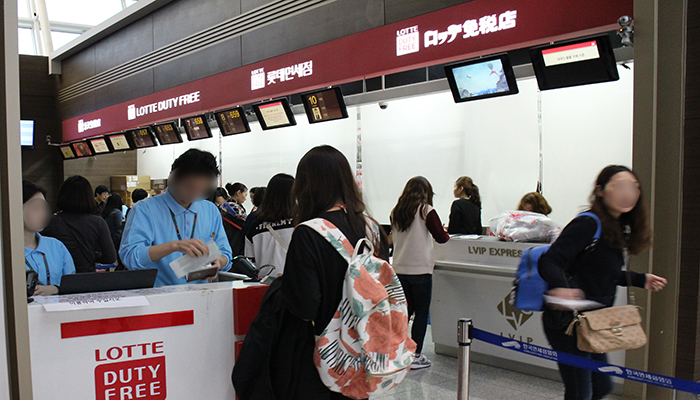It is now necessary to discuss how to expand delivery areas for enhanced user convenience.
I woke up from a sound sleep at the morning call alarm when I was about to get romantic with the Hallyu (Korean Wave) star Kim, Soo-hyeon in a dream. ‘Ah...it was getting just right…’ With a sigh of regret, I looked toward the clock to find it was 9:30 AM. Um..Uh?! Aaah!!!! What shall I do!! I might miss the 11-oclock flight!!! I barely washed my face and packed up in a hurry to make it to the airport just an hour prior to the flight. Whew... I breathed a sigh of relief. Now, all I need to do is to pick up the beauty products that I bought at the downtown DFS and jump on the airplane? As I walked toward the delivery area after entering the departure lounge, I spotted a long and twisted line.
Yes… Murphy’s law is always right. The delivery area for downtown DFS in the airport is so crowded that people are lining up even from outside. I have just 30 minutes before departure. I am supposed to stand by at the boarding gate no later than 30 minutes in advance, but I cannot pass by the delivery area because I already promised gifts of Korean beauty products to all my friends and relatives. I pick up the waiting number slip first and wait in line, but the delivery area clerk says it could take over 40 minutes before I pick up my purchase. As time ticks away, I get more and more nervous. 20 minutes, 10 minutes, 8 minutes... It is driving me crazy!!
Could this Chinese lady who visited Korea on the weekend have boarded her flight with the beauty products that she had purchased? The issue of delivery area lagging far behind the revenue and capacity of downtown DFS growing by leaps and bounds each year has long been a source of headache for the industry.
 Overcrowded DFS Delivery Area in Incheon International Airport
Overcrowded DFS Delivery Area in Incheon International Airport
Korean/global outbound travelers pick up about 70% of their purchases from downtown DFS’s around the nation in the delivery area of Incheon International Airport and the number of customers using the delivery area is rising explosively year in and year out. 9 out of 17 downtown DFS’s are now concentrated in the Seoul Metropolitan Area and, with 3 more to be permitted in Seoul this year, customers using the delivery area of Incheon International Airport are expected to increase more than ever.
To snatch one of two tickets allocated for conglomerate firms, Hyundai Development Company and Hotel Shilla are bent on making headways into the downtown DFS business with their joint corporation, HDC Shilla Duty Free whereas Lotte, WalkerHill (SK Networks), Hyundai DF, and Shinsegae DF, and the like are also strongly committed to expand their reach in the downtown DFS sector, which has turned the downtown DFS business into a matter of primary interest in the domestic distribution industry. HDC Shilla Duty Free revealed a blueprint that, if granted a DFS permit, they would build the biggest DFS of Korea (covering 12,000m2) on the four floors of HDC Hyundai I’PARK Mall, Yongsan. As Lotte is also strongly willing to launch a DFS even if it has to purchase an expensive lot in Shinsa-dong, the combined capacity of downtown DFS’s is expected to grow significantly.
Revenue rises exponentially, yet the capacity of the delivery area is the same as ever
Then, what is the problem? The Korea Customs Act stipulates that goods purchased at downtown DFS’s and online DFS’s be picked up in a delivery area of the departure lounge which is classified as a bonded area. Therefore, delivery areas are always crowded beyond its capacity during busy weekends, vacations, and holiday seasons, resulting in a lot of customer grievances. In particular, a long and twisted line of people is a typical scene found in the delivery area in the boarding area of Incheon International Airport primarily used by international airline passengers. DFS is a cost-effective distribution channel to purchase not only luxury items but also quality goods, but they are picked up with a lot of congestion and hassle even worse than those experienced in traditional street markets.
According to the 2014 Nationwide DFS Revenue report published by the Ministry of Strategy and Finance, the combined revenue of 43 DFS’s nationwide reached KRW 8.3 trillion. Downtown DFS’s posted KRW 5.4 trillion in revenue, accounting for 65% of the total revenue, or more than double the airport DFS’s, which accounted for just 30% with KRW 2.1 trillion. The combined area of delivery area spans approximately 1,297.8㎡, lagging far behind the combined downtown DFS revenue and processing volume.
 A 27 year-old Chinese student identified as Mr. Koh studying in Korea and frequently flying Chinese airlines back and forth between Korea and China said, “There is much room in daytime on weekdays when there are not many people, but it is extremely grueling to wait in line to pick up duty-free goods during rush hours, especially weekend morning, midnight and holidays. Chinese travelers primarily use Chinese airlines, but the delivery area on the fourth floor close to the boarding area for foreign airlines is very small, often requiring people to form a long and twisted queue. As foreigners account for highly significant share of the users, I hope this issue will be addressed for sure.”
A 27 year-old Chinese student identified as Mr. Koh studying in Korea and frequently flying Chinese airlines back and forth between Korea and China said, “There is much room in daytime on weekdays when there are not many people, but it is extremely grueling to wait in line to pick up duty-free goods during rush hours, especially weekend morning, midnight and holidays. Chinese travelers primarily use Chinese airlines, but the delivery area on the fourth floor close to the boarding area for foreign airlines is very small, often requiring people to form a long and twisted queue. As foreigners account for highly significant share of the users, I hope this issue will be addressed for sure.”
“As delivery volume has grown drastically in the wake of the surge in Chinese inbound tourists and each passenger picks up 20 items on average, delivery areas are operated beyond their capacity at peak times of weekdays, on weekends, and during holiday seasons,” explained an official with the Korea Duty Free Association. “Delivery areas need to be expanded about 1.5 times from the current capacity to keep up with the growth rate of duty-free distribution, which calls for cooperation and policy support of customs offices and facility administrators.”
 Photo by Reporter. Koh, Eun-eui/ Delivery area of the boarding area in Incheon International Airport. A customer is leaving the delivery area hurriedly.
Photo by Reporter. Koh, Eun-eui/ Delivery area of the boarding area in Incheon International Airport. A customer is leaving the delivery area hurriedly.
Users are expected to increase explosively next year…It’s high time discussion on amendment to relevant laws started
The Enforcement Decree to the Korea Customs Act defines a delivery area as ‘the site where goods purchased at downtown DFS’s or online DFS’s are picked up by purchasers (Korea Customs Service Notification No. 1-2, amended on Nov. 30, 2011).’ “As negotiation of rent and adjustment of delivery area are sensitive issues for relevant stakeholders, we cannot tell them what to do,” said an official with the Seoul Customs Office. “As far as the delivery areas are concerned, the Korea Customs Service gets involved only to the extent of approving/disapproving based on agreement reached between Incheon International Airport and the Korea Duty Free Association, which are two stakeholders in the operation of delivery area.”
“As available area in the departure lounge which is a bonded area is limited, it is difficult to expand the area,” said an official with Incheon International Airport. “If capacity expansion of the delivery area is necessary to improve the quality of airport customer service, the Ministry of Strategy and Finance having jurisdiction over the restriction of bonded area will review legal viability and instruct us to implement the project.”
The Korea Customs Service notification stipulates that the stakeholders in discussion on the installation of additional delivery areas are ‘conference organizations of bonded sales area.’ In fact, the Council for Bonded Sales Area and Delivery Area of the Korea Duty Free Association and Incheon International Airport are supposed to coordinate the scope of expansion and report their agreement to the Korea Customs Service.
“Since no request has been filed by the stakeholders as to the delivery areas so far, we have assumed that the matter is not so serious,” said an official with the Ministry of Strategy and Finance, “Should legal amendment be necessary to address user inconvenience, we can gather and analyze applicable data and propose a legal amendment if we find it worthy of consideration.” As the number of users outpaces previous forecast, the ministry having primary jurisdiction over the facility is recognizing needs for legal/regulatory amendment in connection with delivery areas.
Considering the factors such as the increase of duty-free limit on hand-carried goods of travelers from USD 400 to USD 600 last September, revenue growth of each online DFS, and addition of new downtown DFS, congestion in delivery area is deemed unavoidable.
The DFS business is the only thriving segment of the domestic distribution industry recently suffering slump with sluggish domestic demands and decline in revenue. As the service quality needs to be bolstered up to improve customer convenience and provide additional boost to the DFS business, it is now essential that relevant stakeholders and government authorities complement and overhaul applicable arrangements in a way to better befit the changed market landscape.


